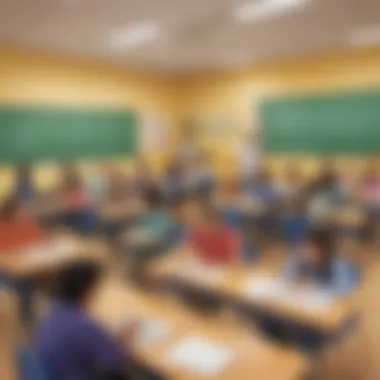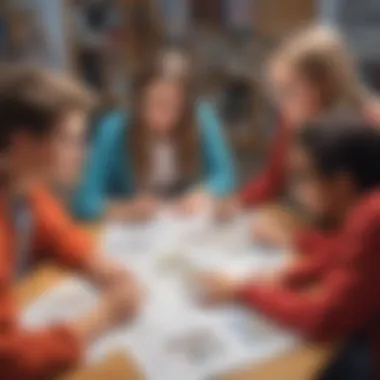Enhancing Student Learning Activities: A Complete Guide


Intro
In the landscape of education, the notion of optimizing learning activities is paramount for realizing effective teaching strategies that cater to diverse student needs. It is not merely about stuffing facts into young minds but about igniting curiosity and fostering a desire for knowledge. As educators, caregivers, and parents discover ways to make learning more engaging and enjoyable, a wealth of innovative methods emerges, blending traditional approaches with modern conversations around educational practices.
The importance of aligning these activities with educational standards cannot be overstated. However, it can be just as crucial to tap into new, interactive methods that resonate with our children today. By creating a vibrant educational environment, learners are not just recipients of information; they become active participants in their educational stories. Through this guide, we delve into various strategies, techniques, and activities, all aimed at enhancing the learning journey for children of different ages.
From exploring engaging interactive games to hands-on DIY projects that foster creativity, this guide provides practical insights and techniques for enriching educational experiences. More importantly, it emphasizes the pivotal role that effective learning activities play in achieving long-term success, both academically and in broader life skills.
Preface to Learning Activities for Students
Learning activities serve as the backbone of educational experiences, shaping how information is absorbed and understood by students. The heart of making education effective lies in the engagement students find through various types of activities. From hands-on projects to technology-integrated tasks, the right activities not only make learning more enjoyable but also more meaningful.
One cannot overlook the importance of tailoring these activities to the developmental stages and interests of students. After all, a preschooler will respond quite differently to a scavenger hunt than a high school student tackling a debate. Thus, understanding how to design learning activities is crucial for achieving desired educational outcomes.
Defining Learning Activities
At the core, learning activities encompass structured tasks or experiences that facilitate learning. They can take many forms, such as discussions, experiments, or interactive games. While some may see a worksheet as a learning activity, it must actually involve student participation or interactivity to be effective. Well-designed learning activities help students attain educational objectives through active engagement.
These activities can also vary widely depending on the subject matter. For a science class, engaging students in an experiment, like growing crystals, is not just more exciting than a textbook lesson; it also deepens their understanding through practical application. Unlike passive learning methods, learning activities encourage students to explore, question, and reflect on their new knowledge.
The Role of Learning Activities in Education
Learning activities play a pivotal role in educational settings. They not only keep students engaged but also help develop critical skills necessary for success in life. When students participate in these activities, they learn to think on their feet, collaborate with peers, and solve problems creatively.
Consider the example of a group project where students are tasked with designing an eco-friendly community garden. Such an activity promotes teamwork, planning, and critical thinking. You're not just teaching them about environmental science; they are learning how to integrate information, develop a plan, and work together toward a common goal.
"Engaging students in learning activities not only enhances their understanding but also prepares them to tackle real-world challenges."
Ultimately, the incorporation of diverse learning activities fosters a rich educational environment that accommodates different learning styles. It shifts the focus from the teacher to the learners, encouraging them to take ownership of their education.
Types of Learning Activities
When it comes to student learning, the types of activities employed can significantly impact engagement and understanding. Recognizing that every student is unique, it's essential to explore various learning activities that cater to different interests and learning styles. Engaging learners in a variety of tasks not only helps solidify knowledge but fosters a richer educational environment.
Interactive Learning Games
Interactive learning games serve as an effective bridge between education and play. These games engage students by turning lessons into challenges or competitions. For instance, platforms like Kahoot! allow teachers to create quizzes that students can answer in real time. This not only promotes healthy competition but also encourages instant feedback, which reinforces learning.
Benefits of interactive games are manifold:
- They capture students' attention more effectively than traditional methods.
- They can quickly adapt to the skill level of each student, providing personalized challenges.
- Students often work in teams, improving their communication skills.
Research indicates that by integrating game mechanics, educators can boost motivation and participation significantly. Think of it as turning the classroom into a mini-arcade where learning happens through fun experiences. As a bonus, these games can often be played from home, allowing for extended learning opportunities.
Hands-On Projects and DIY Activities
Hands-on projects encourage students to take a tangible approach to learning. Engaging in DIY activities enables students to manipulate materials, leading to a deeper understanding of concepts. An example could be constructing a model of a solar system using everyday materials. This tactile approach not only adds an element of creativity, but it also enhances critical thinking skills as students figure out how to construct their models.
These activities contribute to:
- Real-world application of theoretical concepts, bridging the gap between classroom learning and practical understanding.
- Development of fine motor skills and teamwork when students work in groups.
- An avenue for students to express their individuality and creativity.
Creating an atmosphere where students can explore through hands-on experiences cultivates curiosity that is essential for lifelong learning.
Group Activities and Collaborative Learning
Group activities present an opportunity for students to learn from one another. By working together on a project or task, students can pool their strengths and support each other's weaknesses. For example, creating a group presentation on a historical event promotes discussion and peer-to-peer learning, which can reinforce their understanding.
- Collaborative learning also teaches important life skills such as conflict resolution and negotiation.
- It encourages accountability; students learn to depend on their peers and take responsibility for their contributions.
- Furthermore, it promotes diversity of thought, as each student brings their own perspective.
In such activities, the teacher's role shifts to that of a facilitator, allowing students to take the reins of their own learning.
Independent Study and Research Tasks
Independent study fosters self-discipline and responsibility. When given tasks like research assignments or self-directed projects, students learn to navigate resources, analyze information, and draw conclusions on their own. For instance, a student might be tasked with researching their favorite author and presenting their findings to the class. This not only hones their research abilities but builds confidence in their presentation skills.
The benefits of promoting independent study include:


- Encouraging a growth mindset: Students learn that effort leads to improvement.
- Inquiries become personal: When students pick topics that interest them, their intrinsic motivation increases.
- Time management skills: Juggling research time alongside other responsibilities teaches essential planning skills.
However, balancing guidance with independence is crucial in ensuring that students have the support they need while exploring new concepts.
With various types of learning activities clearly articulated, it becomes evident how diversity in teaching methods can cater to different learning needs, ultimately fostering a more inclusive and effective educational landscape.
Benefits of Engaging Learning Activities
Engaging learning activities offer a treasure trove of benefits for students, enabling them to become more active participants in their education. In this section, we’ll explore critical aspects of engaging activities, emphasizing their role in enhancing student learning experiences. Simply put, when students are invested in what they do, they retain knowledge better and develop essential skills that extend beyond the classroom.
Fostering Critical Thinking Skills
Critical thinking often seems to take a backseat in traditional educational settings, where rote memorization can overshadow deeper understanding. However, engaging learning activities inherently encourage students to analyze, evaluate, and synthesize information. For instance, consider a classroom discussion surrounding a complex topic like climate change. When students debate various viewpoints or work together to solve related real-world problems, they learn to think critically about evidence, form reasoned judgments, and navigate disagreements respectfully.
This type of dynamic learning environment nurtures a more profound inquisitiveness, allowing students to ask questions rather than just accept information at face value. Encouraging them to unearth answers fosters skills that are not only vital in academics but will also serve them well in professional settings and everyday life.
"Critical thinking requires patience; it’s not just about knowing the answer but understanding the question well."
Encouraging Creativity and Exploration
Creativity isn’t limited to the arts; it’s an invaluable skill across all subjects and professional fields. When students partake in engaging learning activities, they leave room for imagination to flourish. For example, a science project that involves creating a model of a solar system not only teaches space concepts but also gives students a canvas for their creativity to shine. Different materials can be used, colors can be chosen, and unique designs can emerge, allowing individuality to take flight.
Moreover, such activities invite exploration—pushing students beyond standardized tasks and encouraging them to take risks in their learning. This important facet develops attributes such as resilience, adaptability, and problem-solving, which are vital in our rapidly changing world. Waving the flag for creativity in education can transform the mundane into the magnificent, propelling students toward discovery and innovation.
Enhancing Social Skills Through Collaboration
Collaboration is inherently social, and when learning activities are designed to foster teamwork, the results can be transformative. Group projects or interactive games require students to communicate effectively, share responsibilities, and navigate diverse perspectives. Such environments teach students how to listen actively, compromise, and extend empathy—all critical social skills in both academic and real-world settings.
A practical example is a role-playing exercise where students must work together to solve a crisis. In this scenario, they're harnessing their communication skills to brainstorm solutions and make decisions as a unit. The dynamics of group projects help students strengthen relationships and cultivate a sense of belonging, crucial for their emotional well-being.
Designing Effective Learning Activities
When it comes to education, the design of learning activities plays a pivotal role in shaping student experiences. Crafting effective learning activities ensures not only that students grasp the material, but also cultivates a sense of curiosity and engagement. In essence, taking the time to design learning activities can create a ripple effect that enhances participants’ understanding and retention of knowledge. Additionally, considering different aspects during this design phase can lead to varied benefits.
Aligning Activities with Educational Standards
Aligning learning activities with educational standards is fundamental to ensuring that the curriculum stays relevant and rigorous. This doesn’t just mean sticking to a checklist; it’s about integrating the core objectives into engaging experiences. When activities are tailored to meet specific standards, they provide clear pathways for students to reach desired outcomes.
For teachers, this involves a careful examination of state and national guidelines. They must look at benchmarks that guide subject matter coverage and skill development. By doing this, we can ensure that learning activities are not just fun, but also educationally purposeful.
Some strategies might include:
- Using standards as a foundation for activity purpose and structure.
- Regularly updating activities to reflect any changes in standards.
- Incorporating assessments that align directly with the objectives set by the standards.
"Incorporating standards is like giving a roadmap to where the educational journey should lead."
Incorporating Technology in Learning Activities
In today’s educational landscape, technology isn’t just a nice-to-have, it’s a must-have. Incorporating technological tools in learning activities adds a layer of interactivity and engagement that traditional methods might lack. This could be anything from utilizing educational apps to journeying into augmented reality experiences.
It's beneficial to consider various tools available:
- Interactive Whiteboards: They serve as a dynamic platform for displaying information and sparking discussions.
- Learning Management Systems: Using platforms like Google Classroom or Moodle can streamline assignment management and peer feedback.
- Virtual Reality: Potentially transforming mundane lessons into immersive experiences that grasp students’ attention.
Yet, it is vital that technology use is purposeful. If technology is used merely to replace older methods, it could lead to superficial engagement. As such, every tech integration should foster participation and support learning rather than distract from it.
Adapting Activities for Different Learning Styles
Every student has a unique way of learning. A one-size-fits-all approach simply won't cut it when dealing with the diverse range of students in classrooms. Adapting activities to cater to different learning styles—visual, auditory, and kinesthetic among others—can result in more inclusive and effective educational experiences.
- Visual Learners: These students thrive with diagrams, charts, and videos. Using visual aids can help them assimilate information faster.
- Auditory Learners: For them, discussions, podcasts, or even storytelling can solidify understanding. Incorporating group talks or peer teaching sessions would be beneficial.
- Kinesthetic Learners: Engaging in hands-on projects or physical activities can help these learners feel the subject matter. They might excel at simulations or role plays.
By making the lesson adaptable, educators increase the chances that all students build the skills they need. Moreover, facilitating a variety of learning styles fosters an environment where learners feel valued and understood.
Implementing Learning Activities in Classrooms
Implementing effective learning activities in classrooms takes more than just a plan on paper; it requires a synergy of various elements that foster an inclusive and dynamic learning environment. The heart of every educational setting hinges on how these activities are folded into the daily routine. By emphasizing interaction, collaboration, and creativity, educators can create classroom experiences that resonate with students and encourage their active participation. This section unpacks the components that go into implementing learning activities effectively, addressing the environment in which they occur, time management considerations, and the ways we can assess student engagement.
Creating a Classroom Environment That Supports Learning


A supportive classroom environment acts like rich soil for a plant; without it, even the best seeds won’t thrive. It's crucial to design a space that feels safe, inviting, and stimulating for all students. Here are a few elements to consider:
- Physical Setup: Arrange desks and seating in a way that promotes interaction. You might choose circular seating for discussions or clusters for group activities, as this encourages students to engage actively.
- Ambiance: Make use of bright colors, inspirational quotes, and student artwork. A welcoming atmosphere not only makes students feel comfortable but also stirs their imagination.
- Resources Availability: Ensure that materials and resources are within reach. When students can easily access manipulatives or technology, it reduces downtime during activities, allowing for better flow in lessons.
An environment that promotes learning fosters certain behaviors in students. They are more willing to participate, ask questions, and take risks in their learning. When students feel valued and supported, they are likely to develop a strong emotional connection to the subject matter, making the learning experience richer.
Managing Time Effectively During Activities
Time management is a key player in the success of learning activities. Just like a chef balancing multiple dishes, teachers often have to juggle various tasks to keep the class moving. Here are some strategies that can help:
- Structured Timelines: Break the activities into clear segments. For instance, if a project lasts for a week, allocate specific days for brainstorming, gathering materials, and executing tasks. This helps keep students on track.
- Clear Instructions: Spend some time at the beginning of an activity to explain expectations. Clarity saves time and reduces confusion.
- Monitoring Progress: Keep an eye on how students are progressing midway through the activity. Quick check-ins can help you identify areas where intervention may be necessary which in turn saves precious time and boosts participation.
A well-timed classroom doesn't just enhance student engagement; it gives a structured sense of learning that many students find comfort in.
"For every minute spent organizing, an hour is earned." - Benjamin Franklin
Assessing Student Engagement and Participation
Assessment isn’t merely about grades; it’s also about capturing the essence of student participation and engagement in the learning process. Understanding how students interact with learning activities requires various approaches:
- Observational Techniques: Keep a close watch on student interactions during activities. Are they collaborating? Engaged? Interested? Use checklists to note participation levels, and see which students may need that extra push.
- Feedback Forms: After activities, share feedback forms with students where they can express how they felt about their participation. What did they enjoy? What did they find challenging? This enables a two-way street of communication between students and teachers.
- Peer Assessment: Encourage students to evaluate each other’s contributions. This not only fosters a team spirit but also develops critical thinking skills as students reflect on each others' performances.
It is essential to analyze engagement not just for students’ academic growth, but also for understanding their personal development. A holistic view helps educators adapt future lessons to cater to diverse learning needs.
Implementing learning activities effectively in the classroom sets the foundation for a vibrant learning experience, directly affecting students' motivation and outcomes. Engaging methods not only enhance knowledge but also create a culture of lifelong learners.
Encouraging Parental Involvement in Learning Activities
The role of parents and caregivers in a child’s education cannot be underestimated. When parents participate in learning activities, it produces a knock-on effect that can elevate a child's enthusiasm for education and academic performance. Involving family members can bridge the gap between home and school, creating a supportive learning atmosphere. Here, we will explore how parental involvement fosters a stronger bond that benefits children, leading to greater educational outcomes.
The significant impact parents have can be categorized into several areas:
- Increased Motivation: When parents actively engage with school activities, children often feel more inspired and motivated to learn. It’s like having a cheerleader in your corner; parents can become their child’s emotional anchor.
- Enhanced Understanding of Content: When parents take time to engage in educational activities, they also gain insights into the curriculum. This knowledge helps them provide relevant support to their children, making learning a collaborative endeavor.
- Building a Support Network: Encouragement from family can also foster a sense of belonging. Children who know that their parents are invested in their learning tend to develop more confidence and social interactions, which creates a healthier environment for academic growth.
Thus, the act of getting parents involved isn’t just a good idea; it's a crucial step towards enhancing a child’s education.
Strategies for Parents and Caregivers
- Regular Communication with Teachers: Stay in touch with educators through parent-teacher meetings or emails. This establishes a partnership, enabling parents to understand what their children are learning and how they can contribute.
- Participate in School Events: Encouraging attendance at events like open houses, workshops, or extracurricular activities allows parents to witness the learning environment first-hand and set an example for their children regarding the importance of education.
- Engage in Home Learning: Parents can set aside time to work on projects or review topics of interest. Reading together or conducting simple science experiments can turn ordinary home time into invaluable educational moments.
- Create a Learning-friendly Environment: Setting up a designated study area at home can signal to children that studying is a priority. This environment should have all the necessary tools for homework and encourage focus on educational activities.
- Celebrate Achievements Together: Whether big or small, recognizing and celebrating educational accomplishments can motivate children to strive higher and feel proud of their work.
Communicating the Importance of Learning Activities
To encourage parental involvement effectively, it’s essential to communicate the significance of learning activities clearly. Parents need to understand that fostering a supportive educational framework at home contributes immensely to children's future success. Here are approaches to enhance this communication:
- Educational Workshops for Parents: Schools can host workshops that explain the value of learning activities. Covering topics like how these activities impact critical thinking, creativity, and social skills can make a difference.
- Use Real-Life Examples: Share success stories of students who benefited from parental involvement. When parents see tangible evidence of improvements, they might be more inclined to engage actively.
- Social Media Groups: Encouraging parents to join or establish social media groups centered around educational activities can facilitate dialogue and idea-sharing among parents. It keeps the community connected and informed about what works.
- Regular Updates from Teachers: Periodic newsletters or bulletins detailing what’s happening in the classroom can help parents be proactive in supporting their children’s learning. Knowing what topics are being covered allows parents to engage in relevant discussions at home.
Challenges in Implementing Learning Activities
Learning activities can be an essential part of the educational journey. However, putting them into practice often comes with a set of challenges that educators and caregivers must navigate. These difficulties not only affect how successful the activities can be but also influence students' overall engagement and learning outcomes. Understanding these challenges is crucial for improving the strategies used in educational settings.
One of the first things to consider is that different environments require different approaches. What works in one classroom or home may not be effective in another. Thus, it becomes important to identify the barriers that impede the implementation of effective learning activities.
Identifying Common Obstacles
Several obstacles regularly arise in more traditional educational frameworks. While some are unique to certain contexts, many can be categorized into broader themes:
- Resource Constraints: Schools or homes might lack the necessary materials or technologies. Not having access to appropriate tools can limit the functionality of certain activities.
- Time Limitations: Teachers often juggle numerous responsibilities and may not have sufficient time to effectively plan or execute engaging activities.
- Varied Learning Needs: Classrooms are filled with diverse learners—each with distinct preferences and capabilities. This diversity can make it challenging to design activities that cater to all students.
- Resistant Attitudes: Sometimes, both educators and students resist new methods of learning. Adapting to change can be difficult.
- Lack of Training: Not all educators receive adequate training on how to effectively implement and assess the various learning activities, leading to ineffective outcomes.
These obstacles can create a disjointed learning experience, which may cause students to become disengaged or confused about their learning objectives.
Strategies for Overcoming Challenges
While the barriers seem daunting, there are several strategies educators and caregivers can employ to tackle these challenges head-on:
- Resource Sharing: Collaborating with other teachers or institutions can help share materials and technology. Resource websites and community organizations often provide grants or supplies that can enrich learning experiences.
- Time Management Techniques: Consider using structured planning sessions where educators can prioritize which activities to implement. Using timers or setting clear goals for each session can help make the most out of limited time.
- Differentiated Instruction: Customize activities to match different learning styles. For example, in a science class, some students could conduct experiments while others might work on models or presentations.
- Encourage Open Attitudes: Foster a culture where trying new methods is normalized. Share success stories and encourage both students and staff to see learning as a journey rather than a destination.
- Professional Development: Schools should invest in ongoing training for teachers regarding the design and implementation of learning activities. This can include workshops, seminars, and peer collaboration sessions.
"The true measure of success in education lies not in a single test score but in the incremental progress made through engagement and curiosity."


Focusing on these strategies can not only help to mitigate the identified challenges but also pave the way for more effective and enjoyable learning activities. By addressing guardians' and educators' genuine concerns while integrating innovative methods, we can lay the groundwork for a more engaged and empowered student body.
Evaluating the Effectiveness of Learning Activities
Evaluating the effectiveness of learning activities is a crucial piece in the educational puzzle. Assessing how well these activities work does not just help educators refine their teaching methods but also significantly influences the learning outcomes of students. When educators take the time to evaluate, they can discern which strategies resonate with learners and adjust their approaches accordingly. This process is akin to fine-tuning an engine: without evaluation, one can only guess whether the engine is running smoothly or needs a bit of tweaking.
An effective learning activity allows students to actively engage with the material. It should foster critical thinking, creativity, and problem-solving. Yet, how do we determine whether an activity achieves this? Here are some specific elements to consider in this evaluation process:
- Clarity of Learning Goals: Are the objectives clear? Do they align with educational standards?
- Student Engagement: Are students actively participating, or do they disengage? A half-hearted effort may be an indicator the activity needs rework.
- Collaboration and Communication: Do the activities encourage students to work together and share ideas?
- Outcome Measurement: What methods are in place to assess what students are learning?
When these elements are meticulously evaluated, it becomes easier to see the real impact of learning activities. Moreover, being adept at evaluation can amplify an educator's effectivness, enabling them to cultivate an environment where students thrive academically.
Methods for Assessment
To truly gauge the effectiveness of learning activities, various assessment methods are available to educators. One size definitely does not fit all, so it's vital to choose the right approach or a mix of methods.
- Formative Assessments: These are informal checks for understanding, like quizzes or quick discussions during class. They allow teachers to gauge comprehension in real time.
- Summative Assessments: Conclusive exams or projects at the end of a unit provide insight into what students have absorbed.
- Peer Assessment: Encouraging students to evaluate each other can foster critical thinking and give additional insights into collaborative activities.
- Self-Assessment: Having students reflect on their own learning helps them take ownership of their education.
Utilizing a combination of these methods can give a comprehensive picture of the effectiveness of learning activities, creating a more holistic understanding of students' educational journeys.
Feedback Mechanisms for Continuous Improvement
Feedback is the lifeblood of any educational system. It’s not merely about giving grades but about fostering an iterative process of improvement. Just as a painter examines their canvas from different angles to determine where to add more color or texture, educators must continuously evaluate and implement feedback to enhance their learning activities.
Several feedback mechanisms can be utilized:
- Surveys and Questionnaires: After engaging activities, students can be asked to share their thoughts, which can yield invaluable insights.
- Observation: Teachers can note student interactions and engagement during activities, enabling a more nuanced understanding of participation.
- Reflective Journals: Having students maintain journals where they reflect on their learning experiences can help them articulate their thoughts and feelings about various activities.
- Regular Check-ins: Host one-on-one discussions with students to discuss their experiences can provide candid responses not captured in more structured forms.
Incorporating feedback into the evaluation loop allows for adjustments that propel learning forward. The ultimate goal here is continuous improvement, not only for the educators but also for the learners, cultivating an enriching educational atmosphere.
Remember: Continuous evaluation and feedback lead to an evolving educational landscape, where learning activities are always optimally aligned with student needs.
Evaluating the effectiveness of learning activities hones not only the methods adopted but also enriches the entire educational experience for both students and educators alike.
Future Trends in Learning Activities
As education evolves, so does the landscape of learning activities. These trends shape how students engage and how educators adapt their strategies. Understanding future trends in learning activities is not just an academic exercise; it holds significant implications for formal education systems, fostering an environment that tailors to modern needs. New technologies and personalized learning strategies are reshaping the way we think about teaching and learning, impacting both classroom dynamics and individual student outcomes.
Emerging Technologies in Education
The rise of new technologies is a game changer in educational environments. From virtual reality (VR) to artificial intelligence (AI), these tools are not just flashy trends but integral components of effective learning activities.
- Virtual Reality: Imagine students exploring ancient Egypt or the depths of the ocean without leaving their classroom. VR allows immersive experiences that bring lessons to life, capturing students' imaginations and enhancing their understanding.
- Artificial Intelligence: AI-driven platforms can analyze students' learning patterns and adapt teaching methods accordingly. This leads to a more tailored learning experience, meeting individual needs in real-time.
- Gamification: Incorporating game-like elements into activities makes learning competitive and enjoyable. It can turn mundane tasks into engaging challenges, where students are more likely to participate.
These technologies also bring about discussions on digital literacy and how essential it is for students to be conversant with tools that define future workplaces. Understanding the implications of these technologies prepares students for challenges beyond school walls.
Important Note: Integrating technology is not merely about using the latest gadgets. It involves thoughtful consideration of how these tools enhance not only engagement but also comprehension and retention.
The Shift Towards Personalized Learning Experiences
Personalized learning isn’t just a trend; it’s an educational philosophy that acknowledges that no two students learn the same way. As educators recognize the diversity in student capabilities and preferences, they turn towards strategies that fit varied learning styles.
- Adaptive Learning Environments: Customized learning paths allow students to progress at their own pace. They can spend more time on challenging concepts or accelerate through material they grasp quickly.
- Data-Driven Insights: Teachers can leverage analytics to better understand which strategies work for which students. This data guides intervention strategies, ensuring that support is provided when and where it is needed.
- Student Agency: Encouraging students to take ownership of their learning fosters a sense of responsibility and investment in their educational journey.
Implementing personalized learning experiences requires educators to remain flexible, adapting their teaching strategies to promote a more inclusive atmosphere. Involving students in the process—allowing them to make choices regarding their learning—furthers engagement, making education feel relevant.
In summary, keeping a pulse on these trends is crucial for anyone involved in education, be it parents, educators, or caregivers. As learning activities become more enriched through technology and personalized strategies, our collective approach to education must evolve accordingly. The future is not just about adapting but about creating a more connected and responsive educational ecosystem.
Ending
In wrapping up this exploration of learning activities, it is critical to underline their sheer significance in education. Learning activities are not mere side notes; they form a core part of a student’s educational experience. They blend knowledge acquisition with practical application, allowing students to engage with the material in a way that rote memorization never could. The hands-on experiences and collaborative efforts foster a holistic understanding of concepts. This way, students aren’t just reading about theories; they’re living them, which makes the lessons stick.
The Significance of Learning Activities in Education
Learning activities serve a multifaceted purpose in the educational landscape. They spark curiosity and turn abstract ideas into tangible experiences. When students participate in engaging activities, they gain a deeper understanding of complex subjects. Picture a science class where students conduct experiments instead of just reading about chemical reactions—this approach transforms the learning process from passive to active.
Moreover, these activities play a pivotal role in developing critical skills that extend beyond the classroom. From problem-solving abilities to better communication skills, learning activities offer a framework for personal growth. For instance, group projects teach teamwork and accountability. Not only do students learn academic content, but they also acquire social skills that prepare them for real-world interaction.
"Active learning fosters both knowledge retention and critical thinking, creating learners who know how to think, not merely what to think."
Encouraging Lifelong Learning Attitudes
Cultivating a love for learning is perhaps the most essential gift educators can provide to their students. Learning activities nurture curiosity and instill a sense of discovery, prompting learners to pursue knowledge beyond formal education. When students are frequently engaged through innovative approaches, they’re more likely to remain eager to learn throughout their lives.
Encouraging lifelong learning attitudes means promoting adaptability and resilience in students. As they tackle challenges head-on during engaging tasks, they learn not to shy away from problems but to view them as opportunities to grow. Thus, successfully designed learning activities not only enhance immediate educational outcomes but also equip students with the mindset necessary for continuous self-improvement and exploration.















